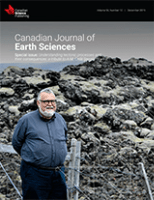
CANADIAN JOURNAL OF EARTH SCIENCES
Scope & Guideline
Championing Quality Research in Geosciences
Introduction
Aims and Scopes
- Geological Processes and Tectonics:
Research focusing on the structural and tectonic evolution of various geological formations, including insights into orogenies, fault systems, and metamorphic processes. - Geochronology and Petrogenesis:
Studies that utilize dating techniques and geochemical analyses to understand the origins, compositions, and evolution of rocks and mineral deposits. - Paleobiology and Fossil Record:
Investigations into the fossil record, including the biostratigraphy and paleoecology of ancient organisms, aiming to enhance our understanding of biodiversity through time. - Environmental and Coastal Geology:
Research addressing geological aspects of environmental change, including coastal processes, sedimentology, and natural hazards. - Climatic and Glacial Studies:
Explorations into the effects of glaciation and climate change on geological formations and sediment transport systems. - Mineral Resources and Economic Geology:
Studies focused on the formation, exploration, and economic significance of mineral deposits, including assessments of their geodynamic settings.
Trending and Emerging
- Climate Change and Geological Impact:
Research examining the geological consequences of climate change, including sediment transport and coastal erosion, is becoming increasingly relevant as environmental concerns gain prominence. - Indigenous Knowledge and Geoscience:
There is a growing integration of Indigenous perspectives and traditional ecological knowledge in geological studies, highlighting the value of these insights in understanding geological processes and resource management. - Geohazards and Risk Assessment:
Studies focusing on geohazards, including landslides, earthquakes, and volcanic activity, are trending as societies seek better understanding and preparedness for natural disasters. - Advanced Geochemical Techniques:
The application of sophisticated geochemical methodologies, such as isotopic analysis and trace element geochemistry, is on the rise, enhancing the understanding of geological processes and resource formation. - Hydrogeology and Water Resources:
Research into groundwater systems and water resource management is increasingly prominent, reflecting the critical importance of water sustainability in the context of climate change.
Declining or Waning
- Paleoclimate Studies:
Research on ancient climate conditions has become less frequent, possibly due to a shift towards contemporary climate impact studies or other more pressing environmental issues. - Non-Mineral Resource Geology:
The exploration of geological features unrelated to mineral resources, such as certain sedimentary or volcanic studies, appears to be declining in favor of more economically relevant topics. - Detailed Biostratigraphic Studies:
While biostratigraphy remains important, the highly detailed studies of specific fossil assemblages seem to be overshadowed by broader ecological and evolutionary research themes. - Low-Temperature Geochemistry:
Analyses focusing on low-temperature geochemical processes have diminished, potentially due to a declining interest in these niche areas compared to high-temperature magmatic studies.
Similar Journals

China Geology
Bridging Gaps in Earth Science KnowledgeChina Geology, published by KEAI PUBLISHING LTD, is a leading open-access journal that serves as a pivotal platform for disseminating high-quality research across a wide spectrum of Earth sciences. Since its inception in 2018, the journal has rapidly established itself with an impressive Q1 ranking in multiple critical categories, including Geology, Economic Geology, and Oceanography, among others, reflecting its significant contribution to the academic community. Positioned as a top-tier journal in the Earth Planetary Sciences domain, it ranks #22 out of 321 in Geology and exhibits an admirable impact in sub-fields such as Earth-Surface Processes and Geochemistry and Petrology. China Geology is committed to promoting rigorous scientific inquiry and facilitating the open exchange of knowledge in the geosciences, making it an essential resource for researchers, professionals, and students eager to explore innovative developments and fundamental advances in geology. The journal’s accessibility ensures that critical findings reach a broad audience, thereby enhancing collaboration and driving forward scientific discourse in the global community.
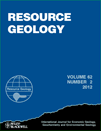
RESOURCE GEOLOGY
Pioneering Discoveries in Earth SciencesRESOURCE GEOLOGY, published by WILEY, is a peer-reviewed journal that serves as a vital platform for the dissemination of innovative research in the fields of geology and geochemistry. With an ISSN of 1344-1698 and e-ISSN 1751-3928, the journal has steadily contributed to the academic community since its inception in 1996, continuing through its planned convergence in 2024. With a Q3 ranking in both Geochemistry and Petrology and Geology categories, RESOURCE GEOLOGY is positioned within the competitive landscape of Earth and Planetary Sciences, ranked 164th and 93rd in its respective categories on Scopus, reflecting its significant contribution to the body of knowledge in these fields. While not an open-access journal, it provides access to essential research that advances our understanding of natural resources and geological processes. The journal is dedicated to publishing high-quality articles that appeal to researchers, professionals, and students looking to deepen their insight into the intricate interplay between geological phenomena and resource management.
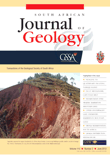
SOUTH AFRICAN JOURNAL OF GEOLOGY
Uncovering the Earth's mysteries, one study at a time.The South African Journal of Geology (ISSN: 1012-0750, E-ISSN: 1996-8590) is a prestigious academic journal published by the Geological Society of South Africa, dedicated to advancing research and knowledge in the field of geology. Established in 1987, this journal has become a cornerstone for geoscientists, featuring a diverse range of studies that address key geological phenomena, particularly within the South African context. With its current quartile ranking of Q2 and an impressive Scopus rank placing it in the 70th percentile among Earth and Planetary Sciences, the journal is recognized for its significant contribution to the discipline. As researchers and professionals across the globe seek to explore and understand geological processes, the South African Journal of Geology stands out as an essential resource, fostering collaboration and innovation in geoscientific research.

STRATIGRAPHY AND GEOLOGICAL CORRELATION
Advancing Geological Insights Through StratigraphySTRATIGRAPHY AND GEOLOGICAL CORRELATION is a prominent scholarly journal published by PLEIADES PUBLISHING INC, featuring a dedicated focus on the fields of geology, stratigraphy, and paleontology. With ISSN 0869-5938 and E-ISSN 1555-6263, this journal has been disseminating significant research findings since its inception in 1994, continuously contributing to the academic discourse through 2024. Despite not currently offering open access, its relevance is underscored by its Category Quartiles for 2023, where it has established itself as Q3 in Geology and Paleontology, and Q2 in Stratigraphy. STRATIGRAPHY AND GEOLOGICAL CORRELATION ranks #29 out of 55 in Stratigraphy and #186 out of 321 in Geology according to Scopus metrics, positioning it within the competitive landscape of Earth and Planetary Sciences. Researchers, professionals, and students are invited to engage with the journal’s content to deepen their understanding and foster innovation within these critical areas of study.

Spisanie Na B Lgarskoto Geologichesko Druzhestov-Review of the Bulgarian Geological Society
Unveiling the complexities of Earth's processes.Spisanie Na B Lgarskoto Geologichesko Druzhestov-Review of the Bulgarian Geological Society, published by the BULGARIAN ACADEMY OF SCIENCE, serves as a leading platform for the dissemination of pioneering research and comprehensive reviews in the field of geology. With the ISSN 0007-3938 and E-ISSN 1314-8680, this esteemed journal underlines its commitment to advancing geological sciences, particularly pertinent to the Bulgarian context but with broader implications for global studies. While the journal does not currently offer open access options, its rigorous peer-review process ensures high-quality publications that enrich the geological literature. The journal aims to bridge the gap between theory and empirical research, fostering collaboration among researchers, professionals, and students. With its strategic location in Sofia, Bulgaria, it stands as a vital resource for those keen on exploring the complexities of Earth sciences and contributes significantly to the prestige of the Bulgarian geoscience community.

Austrian Journal of Earth Sciences
Fostering Global Collaboration in Earth SciencesThe Austrian Journal of Earth Sciences, published by SCIENDO, is an esteemed open-access journal specializing in the disciplines of geology, paleontology, and stratigraphy. With an ISSN of 2072-7151, this journal has established itself as a significant platform for innovative research and scholarly communication in the earth sciences. Since its inception in 2007, it has continuously expanded its influence, achieving notable rankings in the Scopus database—#113 in Geology, #42 in Paleontology, and #21 in Stratigraphy, demonstrating its commitment to high-quality publications. The journal holds prestigious quartile rankings of Q1 in both Geology and Paleontology and Q2 in Stratigraphy as of 2023, reflecting its impact and relevance in the scientific community. Researchers and students alike are encouraged to explore and contribute to the evolving discourse within this dynamic field, as the Austrian Journal of Earth Sciences fosters collaboration and knowledge sharing across global platforms.
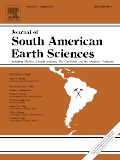
JOURNAL OF SOUTH AMERICAN EARTH SCIENCES
Connecting Past and Present in Earth SciencesJOURNAL OF SOUTH AMERICAN EARTH SCIENCES is a premier interdisciplinary journal dedicated to publishing high-quality research in the fields of Earth-Surface Processes, Geology, and Paleontology, making it an essential resource for scientists and researchers focused on South American geology and its diverse geological phenomena. Published by Pergamon-Elsevier Science Ltd in the United Kingdom, this journal has been instrumental in disseminating groundbreaking studies since 1988, showcasing contributions that push the boundaries of knowledge in Earth and Planetary Sciences. With an impressive Scopus ranking—positioning it in the 74th percentile for Paleontology and 71st for Geology—this journal not only reflects robust academic quality but also its commitment to addressing critical geological challenges in South America. Researchers will appreciate its objective of advancing understanding of geological processes while providing insights into past, present, and future Earth environments. Although available through traditional subscription models, the journal's vast repository of articles enriches the academic landscape, facilitating the sharing of vital research among professionals, students, and geological practitioners.
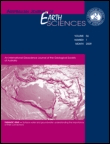
AUSTRALIAN JOURNAL OF EARTH SCIENCES
Bridging Theory and Practice in Earth SciencesAustralian Journal of Earth Sciences, published by Taylor & Francis Ltd, has established itself as a leading journal in the field of Earth and Planetary Sciences since its inception in 1984. With an impactful reach reflected in its ranking as Q2 in the Earth and Planetary Sciences category, the journal contributes significantly to the advancement of knowledge through rigorous peer-reviewed research. While it is not Open Access, the journal ensures broad accessibility through institutional subscriptions and various academic platforms. With a commitment to covering diverse topics within the Earth sciences, including geosciences, geology, and environmental studies, the Australian Journal of Earth Sciences is an essential resource for researchers, professionals, and students seeking to deepen their understanding of the dynamic processes that shape our planet. Engaging with the journal means being part of a vibrant community that aspires to push the boundaries of scientific inquiry and innovation in Earth sciences.

GEOSCIENCES JOURNAL
Fostering Collaboration in Geosciences for a Greener Tomorrow.Welcome to the GEOSCIENCES JOURNAL, a pivotal publication in the fields of Earth and Planetary Sciences and Environmental Science, proudly presented by the Geological Society of Korea. Established in 1997, this journal has become a prominent platform for researchers, professionals, and students, offering a rich collection of peer-reviewed articles that explore a diverse array of geoscientific topics. With an impressive Q2 ranking in both Earth and Planetary Sciences and Environmental Science categories for 2023, it stands as an essential resource in the academic community. Though it operates under a traditional subscription model, GEOSCIENCES JOURNAL remains dedicated to advancing knowledge through rigorous research. Addressed from its headquarters in Seoul, South Korea, the journal aims to foster a deeper understanding of geosciences, encouraging innovation and collaboration in tackling today’s environmental challenges.
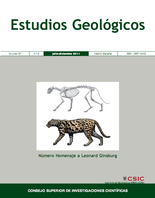
ESTUDIOS GEOLOGICOS-MADRID
Connecting Researchers with Earth’s Secrets Since 1976.ESTUDIOS GEOLOGICOS-MADRID is a prominent journal in the field of geology, published by the esteemed Consejo Superior de Investigaciones Científicas (CSIC) in Spain. Established in 1976, this Open Access journal has been a vital resource for researchers and professionals since its inception. With an impact factor reflecting its contribution to the Earth and Planetary Sciences community, ESTUDIOS GEOLOGICOS-MADRID currently holds a Q3 category ranking in Geology as of 2023, showcasing its relevance and quality within the discipline. The journal publishes a diverse array of geological studies, ensuring wide-reaching access to significant research findings, thereby promoting collaboration and knowledge sharing. Established as a platform for both foundational research and applied geology, this journal fosters academic growth and contributes to understanding the Earth’s processes. Researchers, professionals, and students are encouraged to explore its extensive archive, which includes publications from 1976 to the present. For more information, visit the journal's editorial office at Editorial CSIC, C/VITRUVIO 8, 28006 MADRID, SPAIN.